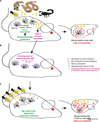Testing the 'toxin hypothesis of allergy': mast cells, IgE, and innate and acquired immune responses to venoms
- PMID: 26210895
- PMCID: PMC4593748
- DOI: 10.1016/j.coi.2015.07.001
Testing the 'toxin hypothesis of allergy': mast cells, IgE, and innate and acquired immune responses to venoms
Abstract
Work in mice indicates that innate functions of mast cells, particularly degradation of venom toxins by mast cell-derived proteases, can enhance resistance to certain arthropod or reptile venoms. Recent reports indicate that acquired Th2 immune responses associated with the production of IgE antibodies, induced by Russell's viper venom or honeybee venom, or by a component of honeybee venom, bee venom phospholipase 2 (bvPLA2), can increase the resistance of mice to challenge with potentially lethal doses of either of the venoms or bvPLA2. These findings support the conclusion that, in contrast to the detrimental effects associated with allergic type 2 (Th2) immune responses, mast cells and IgE-dependent immune responses to venoms can contribute to innate and adaptive resistance to venom-induced pathology and mortality.
Copyright © 2015 Elsevier Ltd. All rights reserved.
Conflict of interest statement
An annotated bibliography with comments about some of the same articles which are cited and commented on in this review is scheduled to appear in the October, 2015 issue of
Figures


Similar articles
-
Mast cells and IgE in defense against venoms: Possible "good side" of allergy?Allergol Int. 2016 Jan;65(1):3-15. doi: 10.1016/j.alit.2015.09.002. Epub 2015 Oct 23. Allergol Int. 2016. PMID: 26666482 Review.
-
Mast Cells and IgE can Enhance Survival During Innate and Acquired Host Responses to Venoms.Trans Am Clin Climatol Assoc. 2017;128:193-221. Trans Am Clin Climatol Assoc. 2017. PMID: 28790503 Free PMC article. Review.
-
The Mast Cell-IgE Paradox: From Homeostasis to Anaphylaxis.Am J Pathol. 2016 Feb;186(2):212-24. doi: 10.1016/j.ajpath.2015.07.025. Am J Pathol. 2016. PMID: 26776074 Free PMC article. Review.
-
IgE and mast cells in host defense against parasites and venoms.Semin Immunopathol. 2016 Sep;38(5):581-603. doi: 10.1007/s00281-016-0565-1. Epub 2016 May 25. Semin Immunopathol. 2016. PMID: 27225312 Free PMC article. Review.
-
Mast cells and IgE in defense against lethality of venoms: Possible "benefit" of allergy[].Allergo J Int. 2020 Mar;29(2):46-62. doi: 10.1007/s40629-020-00118-6. Epub 2020 Mar 2. Allergo J Int. 2020. PMID: 33224714 Free PMC article.
Cited by
-
The Influence of Silver Nanoparticles Against Toxic Effects of Philodryas olfersii Venom.Int J Nanomedicine. 2021 May 25;16:3555-3564. doi: 10.2147/IJN.S293366. eCollection 2021. Int J Nanomedicine. 2021. PMID: 34079248 Free PMC article.
-
Globule Leukocytes and Other Mast Cells in the Mouse Intestine.Vet Pathol. 2018 Jan;55(1):76-97. doi: 10.1177/0300985817705174. Epub 2017 May 11. Vet Pathol. 2018. PMID: 28494703 Free PMC article.
-
Mast Cells in the Skin: Defenders of Integrity or Offenders in Inflammation?Int J Mol Sci. 2021 Apr 27;22(9):4589. doi: 10.3390/ijms22094589. Int J Mol Sci. 2021. PMID: 33925601 Free PMC article. Review.
-
Innate local response and tissue recovery following application of high density microarray patches to human skin.Sci Rep. 2020 Oct 28;10(1):18468. doi: 10.1038/s41598-020-75169-4. Sci Rep. 2020. PMID: 33116241 Free PMC article. Clinical Trial.
-
A Comparison of Natural and Therapeutic Anti-IgE Antibodies.Antibodies (Basel). 2024 Jul 16;13(3):58. doi: 10.3390/antib13030058. Antibodies (Basel). 2024. PMID: 39051334 Free PMC article. Review.
References
-
-
Akahoshi M, Song CH, Piliponsky AM, Metz M, Guzzetta A, Abrink M, Schlenner SM, Feyerabend TB, Rodewald HR, Pejler G, et al. Mast cell chymase reduces the toxicity of Gila monster venom, scorpion venom, and vasoactive intestinal polypeptide in mice. J Clin Invest. 2011;121:4180–4191. ** Studies employing MC-engrafted genetically MC-deficient WBB6F1-KitW/W-v and C57BL/6-KitW-sh/W-sh mice, as well as mice lacking either the MC chymase, MC protease-4 (MCPT4) or CPA3 enzymatic activity, showed that MCs and MCPT4 (which can degrade helodermin, a peptide in Gila monster [Heloderma suspectum] venom that is structurally similar to mammalian VIP), but not CPA3, can enhance host resistance to the toxicity of Gila monster venom. MCs and MCPT4 also limited the toxicity associated with high concentrations of VIP, and reduced the morbidity and mortality induced by the venoms of the Deathstalker (Yellow) scorpion (Leiurus quinquestriatus hebraeus) and the Arizona bark scorpion (Centruroides exilicauda).
-
-
- Higginbotham RD, Karnella S. The significance of the mast cell response to bee venom. J Immunol. 1971;106:233–240. - PubMed
-
- Metz M, Grimbaldeston MA, Nakae S, Piliponsky AM, Tsai M, Galli SJ. Mast cells in the promotion and limitation of chronic inflammation. Immunol Rev. 2007;217:304–328. - PubMed
-
-
Metz M, Piliponsky AM, Chen CC, Lammel V, Abrink M, Pejler G, Tsai M, Galli SJ. Mast cells can enhance resistance to snake and honeybee venoms. Science. 2006;313:526–530. **In studies employing MC knock-in kit mutant mice (i.e., MC-engrafted genetically MC-deficient WBB6F1-KitW/W-v and C57BL/6-KitW-sh/W-sh mice), the authors provided strong experimental evidence in mice that, as suggested by Higginbotham (see refs. and 14), MCs can enhance resistance to the toxicity of whole venoms, in this case the venoms of three snakes and the honeybee, as well as to the toxicity of a component of the venom of the Israeli mole viper (Atractaspis engaddensis), sarafotoxin 6b. By using a phramacological approach, and by employing shRNA to markedly diminish the content of carboxypeptidase A3 (CPA3) in MCs prior to their transfer into genetically MC-deficient mice, this study provided evidence that CPA3 is a MC-associated protease that importantly contributes to the MC’s ability to enhance resistance to the toxicity of whole venom from A. engaddensis and to sarafotoxin 6b.
-
-
- Metcalfe DD, Baram D, Mekori YA. Mast cells. Physiol Rev. 1997;77:1033–1079. - PubMed
Publication types
MeSH terms
Substances
Grants and funding
LinkOut - more resources
Full Text Sources
Other Literature Sources

